Hybrid cucumber “Chinese cold-resistant f1” for growing in regions with harsh climates
When many varieties of cucumbers are grown in regions with an unfavorable climate, the fruits often do not have time to ripen and bring a rich harvest. Recently, in the northern regions of Russia, the Chinese cold-resistant cucumber variety F1 has become especially popular among gardeners.
You will learn all the most important things about this variety from our article - features of agricultural technology, characteristics of fruits, rules for growing by seedlings and seeds.
Description of cucumbers
The hybrid was bred especially for growing in cool and short summer conditions. The culture has won the love of gardeners for its unpretentiousness and unique ability to adapt to different climatic conditions.
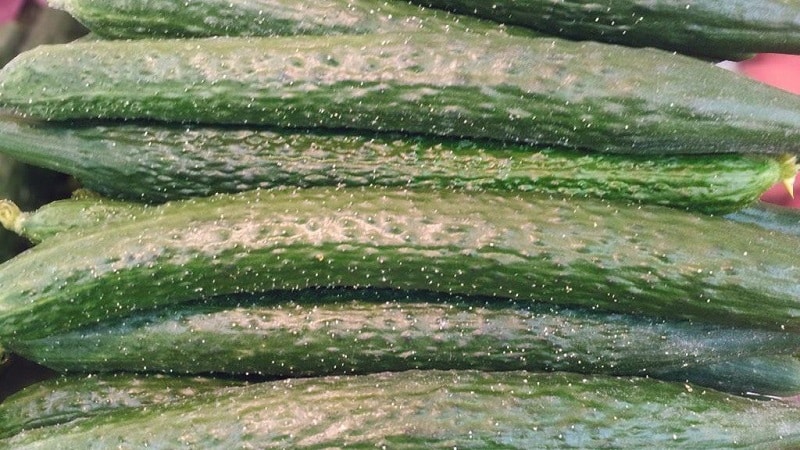
Distinctive features
Chinese cold-resistant F1 - parthenocarpic hybrid with an average ripening period. This means that it does not require pollinating insects to pollinate flowers - it is self-pollinating, its fruits appear without the participation of male flowers.
The variety grows well both in greenhouses and in open ground. The growing season is 50-55 days from the moment the first shoots emerge. A distinctive feature is full yields and excellent taste of fruits even in conditions with low temperatures or in a shady place.
Properties, benefits and calorie content
The calorie content of Chinese cucumber is 14 kcal per 100 g of product. Contains 0.8 g protein, 0.1 g fat and 2.5 g carbohydrates.The fruits contain choline, vitamins K, C, B9, A. Large quantities contain minerals such as potassium, aluminum, sodium, copper, magnesium, fluorine, calcium.
Contained vitamins and minerals are removed from the body harmful substances, contribute to the proper functioning of the heart, kidneys, and improve the functioning of the gastrointestinal tract. Plant fiber cleanses the intestines and stimulates digestion. The fruits are suitable for dietary and baby food.
Characteristics
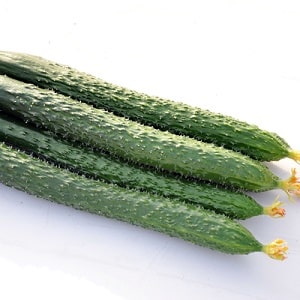 The stem of the plant is strong, with shoots located on it. The fruits grow elongated and sometimes take on a non-standard shape. The color of cucumbers is dark green. If the fruits are not picked on time, they will acquire a yellowish tint, their skin will become rough, and the taste will deteriorate.
The stem of the plant is strong, with shoots located on it. The fruits grow elongated and sometimes take on a non-standard shape. The color of cucumbers is dark green. If the fruits are not picked on time, they will acquire a yellowish tint, their skin will become rough, and the taste will deteriorate.
The pulp of young fruits is juicy and tender. The highest yield of cucumbers is observed in the first 3 weeks. Chinese hybrid cucumbers are best consumed immediately after picking; within a day they begin to wither.
When growing a hybrid, many summer residents notice that at first there are few ovaries, but after the first fruits are picked, their number begins to grow exponentially.
The power and strength of the plant allows it to hold a large number of fruits on the bushes without dropping them or breaking them. If you grow the variety in greenhouses, the yield will increase several times. Under cover, the hybrid is capable of bearing fruit until frost.
The length of the plant's fruit reaches 60-80 cm. The pulp has a pronounced, sweetish taste, somewhat reminiscent of the fresh aroma of watermelon.
Reference. Chinese cold-resistant F1 is a moisture-loving crop.For the plant to fully grow and bear fruit, it is necessary to spray it with settled water, and place a container of water in the greenhouse to maintain the required level of humidity.
Since the hybrid is not suitable for long-term storage and does not tolerate transportation well, it is grown exclusively for personal use and not for industrial purposes.
If you create optimal growing conditions, one bush will bear up to 20-30 kg of fruit.
How to grow your own
Let's consider all the methods of growing a hybrid and the features of agricultural technology.
Read also:
Planting by seedlings
It is best to grow Chinese cucumber using seedlings. — there is a risk of low seed germination when planted directly into the ground.
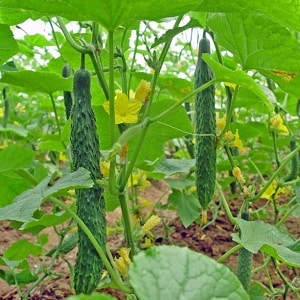 First, the seeds are checked for germination. To do this, dissolve 1.5 tbsp in 1 liter of water. spoons of salt and place them in the solution. Full seeds will float, they need to be washed and dried. It is better to heat the selected seeds in a thermostat at a temperature of up to +50 °C for three hours and disinfect them in a solution of potassium permanganate for half an hour.
First, the seeds are checked for germination. To do this, dissolve 1.5 tbsp in 1 liter of water. spoons of salt and place them in the solution. Full seeds will float, they need to be washed and dried. It is better to heat the selected seeds in a thermostat at a temperature of up to +50 °C for three hours and disinfect them in a solution of potassium permanganate for half an hour.
After the preparatory procedures, the seeds need to be germinated on a damp cloth, and then plant in separate containers. Place a layer of drainage at the bottom of the containers; store-bought soil is suitable as soil.
When the seeds germinate, they are planted in the ground to a depth of at least 1.5 cm. The container is placed in a warm place and covered with polyethylene or glass on top to create a greenhouse effect. The shelters are removed after about a week, when the first shoots sprout.
The seedlings are placed on the windowsill in a well-lit place. Optimum temperature range +23… +25 °C, without drafts.
Before planting seedlings in open ground, install a trellis or supports in the garden bed. Plants are planted in pre-prepared holes, placing 4 bushes per 1 m of bed. This will ensure good growth of the plants and they will not interfere with each other. Seedlings grown in peat pots are planted with them. After planting, the plants are watered abundantly.
Planting by seed
Some gardeners prefer planting Chinese cucumbers in the ground with seeds. In this case, you should wait until the earth has completely warmed up. Its temperature should be +13… +20 °C.
The holes in which the seeds are sown are placed at a distance of 5 cm from each other. Between rows of holes a distance of half a meter is maintained. Because the seeds may not germinate well; at least three seeds are placed in each hole. The depth of the holes for seeds in the soil should be 3-4 cm.
After the first shoots appear, thinning is carried out, leaving the shoots at a distance of 10 cm from each other. The next thinning is performed after several leaves appear on the sprouts. As a result, the distance between plants should be 25-30 cm.
Reference. Since Chinese cold-resistant F1 is a hybrid and not a variety, you won’t be able to collect the seeds yourself - they are purchased from trusted suppliers.
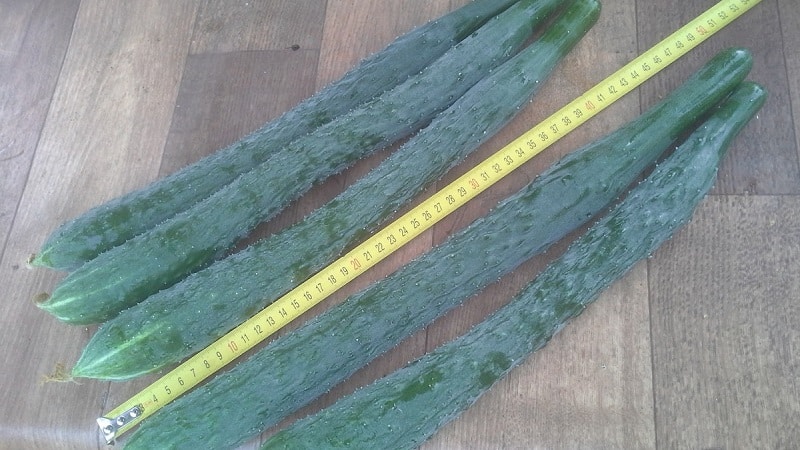
Growing in stages and care
When growing the Chinese cold-resistant F1 variety, there are practically no problems, and care is no different from caring for other types of cucumbers.
The variety is often planted in June so that it bears fruit in the fall. Seedlings are planted in May. Well-lit areas are chosen for planting.
Only young shoots need special care. They are watered with water at room temperature and protected from direct sunlight.
In the following, general rules apply:
- grow vertically;
- tie up bushes;
- feed with mineral fertilizers;
- water daily (in the evenings);
- Pick ripe fruits on time.
Used for feeding infusions of onion peels or ash.
Important! In order for the fruits to be even and beautiful, it is better to tie up the plant; the hybrid has a tendency to grow in different directions, as a result the fruits can turn out ugly.
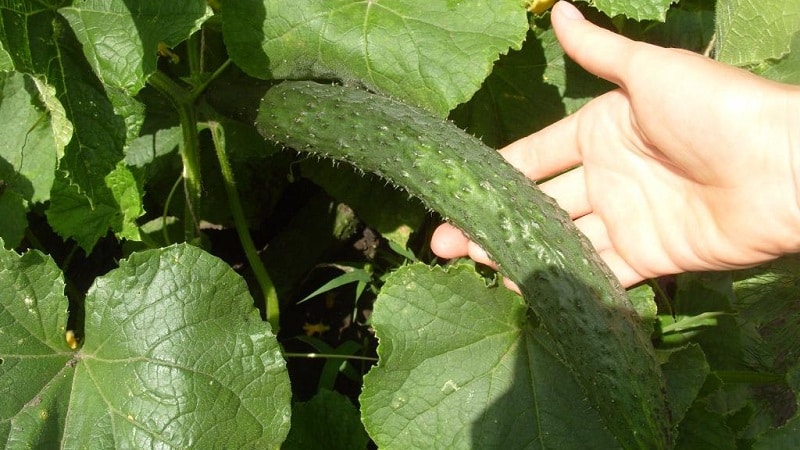
Features of cultivation and possible difficulties
Problems with growing a hybrid rarely arise.
The plant forms long vines, which without a garter can break under the weight of the cucumbers. At the first stages of growing seedlings, it is necessary to prune - remove 5 side shoots located in the lower part of the bush, and after the fruits appear, remove all excess leaves and young fruits that differ from normal ones in color or texture.
Plus of the variety - low probability of lateral growth formations, but if it does appear, the extra stepsons are removed. Their appearance will have to be monitored throughout the growing period.
Do not forget to periodically loosen the soil, weed and mulch the soil.
Possible difficulties and ways to deal with them:
- If a plant has a problem with unnaturally thin fruits, this means a lack of boron. Perform foliar feeding with a solution of boric acid: a quarter teaspoon of the substance per 1 glass of water.
- Yellow edging of leaves and fruit hooking means nitrogen deficiency. Fertilize with ammonium nitrate (2 tablespoons of fertilizer per bucket of water).
- If the fruits have a pear-shaped shape, you need to fertilize them with potassium fertilizers, for example, potassium sulfate at the rate of 20 g per 10 liters of water.
- In case of blackening, drying of the tips of the leaves, or stunting of fruit growth, use foliar fertilizing with calcium nitrate: 2 g of the substance per 1 liter of water.
- Purple foliage indicates a lack of phosphorus. You need to fertilize with superphosphate (35 g per 10 liters of water) or wood ash (1 cup per 10 liters of water).
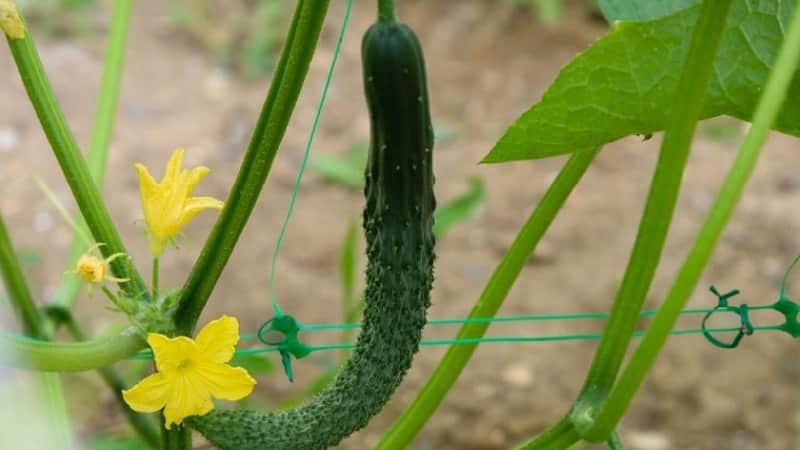
Typical diseases and pests
The hybrid is resistant to fungal diseases such as real and false powdery mildew, fusarium wilt.
However, despite its resistance to cucumber diseases and pests, the Chinese variety can still encounter them. Besides, can harm the plant spider mite And aphid. The most common cause of the disease is excess moisture in the soil.
To protect the plant from such diseases, apply the following preventive measures:
- provide sufficient distance between plants in the garden bed;
- make sure that there is no excess moisture in the soil;
- sprinkle the beds with mulch to reduce the likelihood of weeds and pests;
- in case of pest damage, use solutions of herbicides and insecticides;
- if affected areas are found, remove the lashes from the garden bed and destroy them outside the garden;
- To prevent diseases, use an infusion of garlic and onion peel;
- If root rot (fusarium) is detected, treat the stems of the bushes to a height of 15 cm from the ground with a solution of pharmaceutical iodine (in a ratio of 1:2).
Important! To get an environmentally friendly harvest, you should not treat cucumbers with chemicals. It is best to use harmless folk remedies available in every home.
Harvesting and application
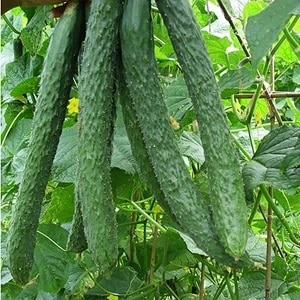 To prevent cucumbers from overgrowing, pick them daily.. The first cucumbers appear 1.5 months after germination.Once the fruits appear, you cannot delay harvesting, otherwise they will turn yellow. In a greenhouse, the crop is harvested before the first frost, in open ground - until September.
To prevent cucumbers from overgrowing, pick them daily.. The first cucumbers appear 1.5 months after germination.Once the fruits appear, you cannot delay harvesting, otherwise they will turn yellow. In a greenhouse, the crop is harvested before the first frost, in open ground - until September.
In order not to harm the plant, it is recommended to use pruners or a knife when removing fruits. It is better to harvest in the early morning or evening; after harvesting it is advisable to water it.
Chinese cucumbers are not stored for a long time; they are best consumed fresh within 24 hours after picking.. Greenhouse cucumbers are stored at a storage temperature of +10 ° C and a humidity of 90%, and those grown in open ground - at a temperature of +7 ° C and a humidity of 90%. In such conditions, cucumbers are stored for 7 days.
To increase shelf life, they can be kept in a cool place or refrigerator at a temperature of +4 ° C.
Despite the fact that cucumbers have an elongated shape and are more suitable for fresh use in salads, housewives have learned to preserve them in slices.
Advantages and disadvantages
Advantages of a hybrid:
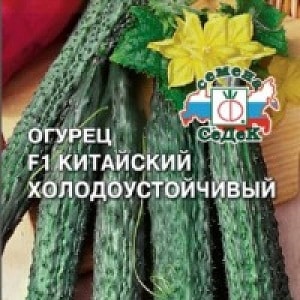 high yield;
high yield;- fast ripening period;
- long fruiting;
- shade resistance;
- resistance to cold weather;
- ability to self-pollinate;
- resistance to diseases.
Flaws:
- short shelf life;
- not suitable for long-distance transportation;
- not suitable for traditional pickling;
- requires exclusively vertical cultivation, otherwise the fruits will be deformed;
- low seed germination.
Reviews
Summer residents love this variety for its resistance to cold. and the most dangerous diseases of pumpkin plants.
Maria, 34 years old: “We had a cool summer that year, and out of curiosity, I decided to test the hybrid for cold resistance - I didn’t install a greenhouse, but planted it in open ground.As expected, the cucumber turned out to be cold-resistant, but it does not like sudden temperature changes. With the onset of cold weather, the yield begins to gradually decrease, but the taste remains the same. We love cutting it into salads. The cucumbers are beautiful in appearance: even, smooth, long, taste crispy, fresh and juicy.”.
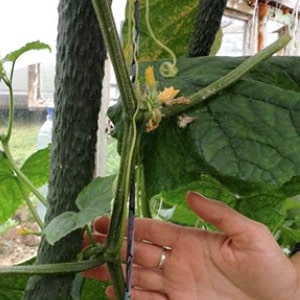 Ivan, 53 years old: “This is not the first time we have imprisoned the Chinese. I like their fast and high yield; the cucumbers taste juicy, without seeds, and do not taste bitter. The first time when planting, I didn’t tie them up, and the fruits turned out uneven, but the next time I started tying them up on trellises, and the hybrid produced smooth, even fruits. There was fruiting even in September. We like to eat cucumbers in salads in the summer, and my wife salts them in slices in a jar.”.
Ivan, 53 years old: “This is not the first time we have imprisoned the Chinese. I like their fast and high yield; the cucumbers taste juicy, without seeds, and do not taste bitter. The first time when planting, I didn’t tie them up, and the fruits turned out uneven, but the next time I started tying them up on trellises, and the hybrid produced smooth, even fruits. There was fruiting even in September. We like to eat cucumbers in salads in the summer, and my wife salts them in slices in a jar.”.
Tatyana, 41 years old: “I planted the hybrid by accident, because... the seeds were given to me as a gift when I left. I was very pleased with the cucumbers with their taste (thin skin, juicy pulp, small seeds, rich cucumber aroma) and appearance (length more than 30 cm, even, smooth). All the seeds from the pack sprouted, which is indicative. I watered it all summer because it was dry. The fruits lasted until October. One bed provided us with cucumbers for the whole summer for salads, and even enough for pickling (of course, only in pieces).”
Conclusion
By providing care and attention, you can easily grow a rich harvest of fragrant, crunchy fruits of the Chinese cold-resistant hybrid in your garden bed.
Cucumbers grown according to all the above rules will diversify the menu and provide the family with vitamins and nutrients for the whole summer. Such advantages of the crop as early ripening, productivity, resistance to diseases and cold will not cause much trouble in cultivation and care.Despite the fact that the fruits have an elongated shape, they are used for preservation by cutting into slices.